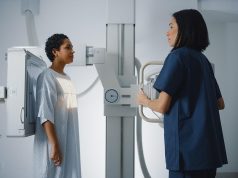In postmenopausal women, breast cancer incidence down with estrogen alone, up with CEE + MPA
FRIDAY, Dec. 13, 2019 (HealthDay News) — For postmenopausal women, conjugated equine estrogen (CEE) alone is associated with a long-term decrease in breast cancer incidence, while CEE plus medroxyprogesterone acetate (MPA) is associated with increased incidence, according to a study presented at the annual San Antonio Breast Cancer Symposium, held from Dec. 10 to 14 in Texas.
Rowan T. Chlebowski, M.D., Ph.D., from the Harbor-UCLA Medical Center in Torrance, California, and colleagues examined the long-term effect of CEE plus MPA versus placebo for women with a uterus or CEE alone versus placebo for women with prior hysterectomy. Participants were postmenopausal women aged 50 to 79 years.
The researchers found that CEE use alone was associated with a significantly reduced breast cancer incidence during the intervention period (hazard ratio, 0.76), with a greater reduction for women with no prior hormone therapy (HT) use and with a gap time of at least five years. Through 16.1 years of cumulative follow-up, CEE use alone continued to be associated with a significantly reduced incidence of breast cancer (hazard ratio, 0.77), while subgroup differences were no longer significant. CEE plus MPA use was associated with a significantly increased breast cancer incidence (hazard ratio, 1.26) during the intervention period, with a greater increase for women with prior HT use and women with a gap time of less than five years. CEE plus MPA continued to be associated with a significant increase in breast cancer incidence through 18.3 years of cumulative follow-up; subgroup differences were no longer significant.
“The discordance between the randomized clinical trial findings with respect to estrogen alone use and observational findings are difficult to reconcile,” Chlebowski said in a statement.
One author disclosed financial ties to the pharmaceutical industry.
Copyright © 2019 HealthDay. All rights reserved.








